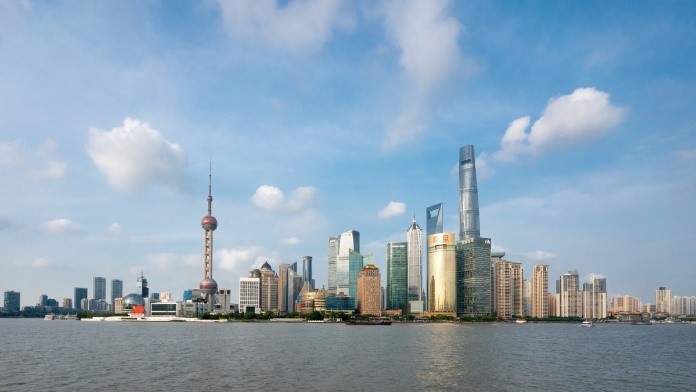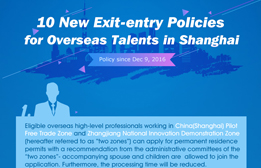What they say | Pudong's 34 years of development

The financial district of Pudong New Area. [Photo by Gao Erqiang/China Daily]
Shanghai's Pudong New Area commemorated its 34th anniversary on April 18, marking a significant milestone in its journey of growth and transformation. Established in 1990, Pudong has evolved into a hub of innovation and progress, symbolizing the spirit of China's reform and opening-up.
As part of the celebrations leading up to this special day, over 60 ordinary residents who live, work, and do business in Pudong were invited by the local government to visit the Pudong Exhibition Hall, where they explored the "Reform and Opening-up of Pudong" exhibition, reflecting on the remarkable changes Pudong has undergone over the past 34 years.
Among the visitors were four individuals, each with a unique story to tell, united by their identity as Pudong residents. These individuals represent the diverse fabric of Pudong's community and have witnessed firsthand the dynamic transformations across various sectors within the region.
As Pudong celebrates its 34th anniversary, these stories of resilience, innovation, and community spirit exemplify the essence of a region that continues to push boundaries and embrace the future with open arms. Through the voices of its residents, Pudong's journey of development and openness shines brightly as a beacon of progress in China's dynamic landscape.
Researcher: Dialoguing with the forefront of the industry
One of the visitors, 24-year-old Huang Jingtao, a native of Hubei province, is currently pursuing his Ph.D. at the Tsung-Dao Lee Institute of Shanghai Jiao Tong University. Standing before a display board at the exhibition, Huang was captivated by the achievements showcased: from the establishment of major scientific facilities to the booming sales revenue in integrated circuits and the burgeoning biopharmaceutical industry.
He carefully read through every set of numbers: Pudong already has 14 major scientific facilities that are completed or under construction; in 2023, the area’s integrated circuit sales revenue reached 246.4 billion yuan ($34.15 billion), accounting for approximately 75 percent of the city's total; and it has attracted over 11,000 biopharmaceutical companies worth 378.2 billion yuan.
For Huang, Pudong embodies his vision of internationalization and modernization. "Take our Lee Institute for example, our daily working language is English. Top physicists from both domestic and international arenas often come to the Lee Institute for exchanges. In our research group, we have a Ph.D. student from Ireland. Every week, there are two or three international seminars related to my research field alone."
The Lee Institute is located in Zhangjiang Science City. In 1992, the predecessor of Zhangjiang Science City, Zhangjiang High-Tech Park, was established, becoming one of the first national-level new areas. Over the past 30 years, Zhangjiang has gathered over 18,000 enterprises and formed dominant industries focusing on information technology and biopharmaceuticals, with a strong foundation in basic research capabilities.
Engaged in the TRIDENT (TRopIcal DEep-sea Neutrino Telescope) Project, a groundbreaking initiative to build the world's largest deep-sea neutrino telescope in the western Pacific Ocean, Huang recognizes Pudong's prowess in advanced industrial capabilities, particularly in marine engineering and shipbuilding.
This unprecedented deep-sea project was initiated by scientists at the Lee Institute to explore the universe. According to the conceptual design, the research team will construct a detector array with a diameter of about 4 kilometers and covering an area of about 12 square kilometers on a deep-sea plain approximately 3.5 kilometers deep near the equator in China's territorial waters. The array consists of 1200 cables, each carrying 20 optical detection spheres, resembling a string of bells in the deep sea, quietly awaiting the arrival of high-energy neutrinos.
Huang said that China began conducting basic research in physics later than Western countries. "If we want to surpass the West, our current greatest competitive advantage lies in our advanced industrial production capabilities." For the TRIDENT Project, there is a need for a strong level of deep-sea industrial manufacturing to build such a large-scale deep-sea engineering facility. "Pudong is leading in the development of shipbuilding and marine engineering equipment industries, which gives it a natural advantage."
As more and more young people come to Pudong and engage in basic scientific research fields, they will also bring a different kind of vitality. "Many of our classmates now live in the Zhangjiang campus of Shanghai Jiao Tong University. The surrounding transportation and shopping options are very convenient, and we also like to volunteer and work as guides at the Shanghai Astronomy Museum together."
One of the activities that Huang is most enthusiastic about is walking along the riverside trail next to the Lee Institute. "That is a fitness trail specially created for the Lee Institute in Pudong, exactly 1 kilometer in circumference. When you walk there, you can easily encounter industry 'big shots' from various countries. You can chat with them and ask them questions at any time. This free and relaxed academic atmosphere inspires the imagination."
Business traveler: Connecting the world within a half-hour drive
In the past couple of years, Yu Miao, also one of the visitors, has been constantly on the move. In October 2023, Easpeed Holographic (Shanghai) Intelligent Technology Co Ltd, a wholly-owned subsidiary of Easpeed Tech, was officially established in Pudong’s Jinqiao area. Yu, the general manager, leads the research and development team and the sales team, based in Shanghai but with a global perspective, seeking larger markets for the company's technological products.
While visiting the exhibition, Yu specifically searched for old photos of Jinqiao. "I'm particularly curious to know what it looked like 34 years ago." In April 1990, the Jinqiao Export Processing Zone was established in Pudong. In the same year, in September, the State Council approved the Jinqiao Export Processing Zone to enjoy national-level policies for economic and technological development zones.
Jinqiao has developed an industrial layout centered around "future vehicles", "intelligent manufacturing", "large screens", and "modern productive services". After a thorough investigation, Easpeed Tech chose to set up operations in Jinqiao, valuing the industrial ecology and environment in the area. "We hope to connect with leading technology companies in the park, collaborate, and create more fascinating application scenarios through innovative technology."
As a leading company in the field of virtual reality technology, Easpeed Tech's core product is naked-eye 3D technology. Yu explains, "Traditional holographic images rely on media. Our technology can achieve interaction without the need for any wearable devices, making scenes from movies like 'Iron Man' a reality." This technology is now being applied in intelligent cabins, healthcare, civil engineering, smart homes, exhibitions, and more.
With the establishment of the subsidiary in Pudong, Easpeed Tech has opened the door to internationalization. "We have set up showrooms in Shanghai, allowing customers from around the world to experience our application scenarios firsthand; we have also expanded cooperation with many leading companies and multinational corporations. More importantly, capital from regions like the Middle East is now coming into Chinese companies through this window in Shanghai. We are at the forefront when it comes to connecting with the world, making it easier for the outside world to understand our value," said Yu.
Today, Yu and many of her colleagues live in Pudong. As a frequent traveler, Yu has her reasons for choosing to live in Pudong. "Pudong's efficient services are very traveler-friendly. And living in Pudong, it only takes a half-hour to drive from anywhere to Pudong Airport for business trips. In essence, within half an hour, I can connect with the whole world."
Entrepreneur: Valuing opportunities toward the future
Another visitor, Wang Daoyu, shared his deep connection with Pudong, having witnessed its evolution over the years. From his early days of exploration in the region to founding his medical technology startup, ZD Medtech, Wang has seen Pudong grow throughout his entrepreneurial journey.
Today, ZD Medtech boasts a team of nearly 200 individuals and has developed cutting-edge rehabilitation robotics and intelligent medical devices with a global reach. Wang attributes his company's success to Pudong's forward-looking opportunities and the city's reputation for fostering innovation and trust in international markets.
In 2006, during his first year of university, he set foot in Pudong for the first time. Starting from his school in Yangpu district, he wandered for two hours before finally arriving in Pudong’s Zhangjiang town. "Back then, Zhangjiang was just like a small town."
In 2009, due to an internship, he lived in the Zhangjiang High-Tech Park area. "At that time, this place was still relatively remote."
Later on, he began his entrepreneurial journey. Through a series of fortuitous events, he participated in the Zhangjiang High-Tech 895 Entrepreneurship Camp, and he officially moved ZD Medtech into Pudong.
Today, at 34 years old, Wang is "the same age" as Pudong. The places that once left him slightly underwhelmed have undergone tremendous changes.
"I remember when a colleague bought a new house in Tang town, Pudong, years ago, I always felt it was so far from the city center. Now, it's a mature community, and it feels a bit 'out of reach'." Years ago, Wang had to drive 30 to 40 minutes to reach Century Park to treat clients to a meal. Nowadays, the elevated roads and highways in Pudong have connected the area from all directions. "Get on the elevated road, and you'll arrive in 10 minutes." Zhangjiang High-Tech Park is also now home to numerous buildings and thriving businesses. "It's much more convenient for business meetings."
Wang's career development has paralleled the development of Pudong. He said that from an initial team of fewer than 10 people, the company now has nearly 200 employees. ZD Medtech now has the capability to autonomously design and develop various modules of intelligent robots, constructing dozens of technological platforms with complete independent intellectual property rights and a systematic and integrated framework across multiple disciplines. It has independently developed over ten globally leading rehabilitation training robots for upper and lower limbs and intelligent rehabilitation hardware and software terminals, with over 100 patents, and their core products are now used in nearly a thousand hospitals.
In Wang's view, his generation was born at the right time for entrepreneurial endeavors. Choosing Shanghai, choosing Pudong, turned out to be the right choice for a group of innovative enterprises including ZD Medtech.
"In fact, over the years, many cities with advantages in later development have extended olive branches to us. Why do we still stay in Pudong? It's because we value the opportunities Pudong offers, opportunities that are global-facing and future-oriented. We see that the international market has a high level of trust in Shanghai companies and a high level of recognition for Shanghai products. We require this market trust to reach further, to achieve our life dreams, and to fulfill the recovery dreams of patients," Wang said.
Elderly resident: Embracing change in the neighborhood
Among the visitors was 80-year-old Chen Liuchao, a long-time resident of Pudong who has witnessed the area's transformation firsthand. From the bustling streets of the past to the modern amenities and green spaces of today, Chen reflects on the changes that have shaped his community.
Living in the Meiyuan neighborhood in Lujiazui, Chen appreciates the convenience and vibrancy of his surroundings. With improved infrastructure, accessible healthcare, and revitalized public spaces like Meiyuan Park, residents like Chen enjoy a quality of life that reflects the essence of a global metropolis.
Chen is highly aware of the changes that have occurred in Lujiazui. "What everyone sees is taller buildings being constructed and more young professionals moving in. Some say the skyscrapers represent Lujiazui's 'A side', while the older communities we live in represent the 'B side' of Lujiazui, but I disagree. Our way of life can fully represent an international metropolis."
Chen vividly describes his current daily life: getting up early every morning and walking and practicing martial arts at Meiyuan Park next to his community. In recent years, to better meet the needs of residents for green spaces, Pudong has actively promoted 24-hour park access and the opening up of green areas. Since last year, Meiyuan Park has been open 24 hours a day, with all fences removed. "In the morning, the elderly go for walks, and in the evening, young people go for runs. It's very pleasant."
In the morning, Chen occasionally goes to nearby hospitals to pick up medication or receive physical therapy. "Not to mention the dozens of nearby bus routes and the convenience of reaching tertiary hospitals, even our community hospital now offers a wide range of services. For minor ailments, I can ride my bike there and back in a maximum of 30 minutes."
At noon, the community canteen is bustling with elderly residents. "If we don't feel like cooking at home, we'll go out—it's convenient and affordable."
In recent years, Pudong New Area has been promoting the construction of high-quality urban areas, and the subtle changes in the city's appearance have garnered praise from these elderly residents. "Take our neighborhood, for example; the roads have been renovated, the walls repainted—it feels like living in a new house. Is that not wonderful?"
The transformation of Lujiazui offers a small glimpse into Pudong's 34 years of development and openness. But for people like Chen who live here, it's a choice that has defined half of their lives. "Now my daughter, and her children, all live in Pudong. We all love this place."

 Print
Print Mail
Mail




